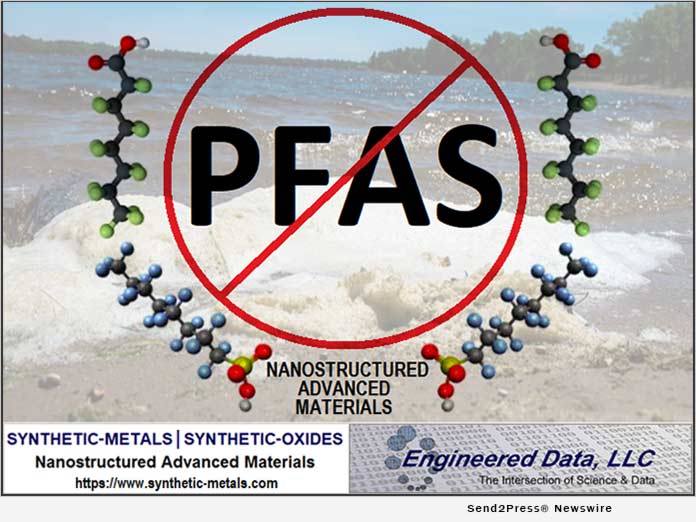
WASHINGTON, D.C., Jul 20, 2020 (SEND2PRESS NEWSWIRE) — Engineered Data, LLC’s Advanced Materials Group has begun micro-batch production of a Flocculant that remediates PFAS chemicals (as well as Toxic Heavy Metals + Phosphate [a main ingredient in Storm Water Pollution + Algae Tides]) from polluted water. Jar-testing samples are available to entities interested in applications testing advanced technologies that improve remediation performance.
The 3 conventional technologies for remediating PFAS chemicals from water are Activated Carbon, Ion Exchange Resins + High-Pressure Membranes. Today, a 4th technology is added to that list. Sourced from Military Research and scientifically classified as Nanoporous Iron Oxide (“NIO”), our Flocculant comes in 2 grades: NIO-G (premium) and NIO-C (standard).
Little published research on nanostructured sorbents like NIO exists. Hence researchers like the PFAS Specialists at The Interstate Technology Research Council (https://pfas-1.itrcweb.org/) tend to classify NIO as a Hybrid: part Nanofilter (NIO has nanometer-sized pores, but doesn’t utilize membranes), part Flocculant (NIO removes colloids, not by single-function ionic aggregation, but by dual-function aBsorption + aDsorption).
Extraordinarily high surface area (one gram of NIO has enough surface area to cover 3.33 US football fields) and [2] concurrent micro + meso porous particle architecture (verified by independent lab: https://www.synthetic-metals.com/Isotherm2019.pdf) give NIO its accelerated remediation speed + increased capacity. For example, when tested against Phosphate in very high concentrations (+/-25mg/L: typical algae bloom phosphate concentrations hover below 5mg/L), NIO remediates more phosphate in 1 minute than National Science Foundation (NSF) Certified flocculants + sorbents can in 48 hours … even when NSF flocculants + sorbents are given a 20X dosing handicap. Skeptical? Watch the video (https://www.youtube.com/watch?v=UVFCLif0eqE).
Univ. of Arizona + Rice University Researchers confirmed the efficacy of iron oxide (Fe2O3) nanoparticles for remediation of PFAS in 2012 (https://www.synthetic-metals.com/UnivArizona_PFOA-PFOS.pdf). Based on aggregate surface area comparisons, NIO (also Fe2O3) is estimated to be 17.5X more powerful than the nanoparticle mixture used in 2012. NIO is also safer than nanoparticles, as nanoparticles, once introduced into water, either dissolve or become suspended and disburse, becoming logistically impossible to recover. NIO safely sinks to the bottom of settling tanks for easy removal in as little as 30 minutes. NIO is projected to perform best against PFAS chemicals in environments where PFAS concentrations are highest and the pH level of water being treated can be adjusted below +/- 6.0.
For more information, go to https://www.synthetic-metals.com.
ABOUT ENGINEERED DATA, LLC:
ENGINEERED DATA, LLC is a Washington, D.C. based Technology Firm that custom builds software solutions across a wide array of platforms that enable federal & commercial clients to reach their operational, financial + logistical goals. Profits from software development activities self-fund development of niche-dominating, best-in-class systems + inventions. ENGINEERED DATA LLC’s Advanced Materials Group has patents awarded + pending in the field of Nanostructured Sorbents and is a pioneer in the field of Centrifugal Sintering.
MEDIA CONTACT:
Tim Rolf
President: Engineered Data, LLC
(202) 716-9400
timrolf@engineereddata.com
*VIDEO (YouTube): https://youtu.be/UVFCLif0eqE
*IMAGE link for media: https://www.Send2Press.com/300dpi/20-0720s2p-engin-data-300dpi.jpg
Social tags: #PFAS #PFOA #waterpollution
News Source: Engineered Data LLC
Related link: https://www.engineereddata.com/
This press release was issued on behalf of the news source, who is solely responsible for its accuracy, by Send2Press Newswire. To view the original story, visit: https://www.send2press.com/wire/engineered-data-llc-announces-the-worlds-1st-flocculant-for-remediation-of-pfas-chemicals-from-water/


